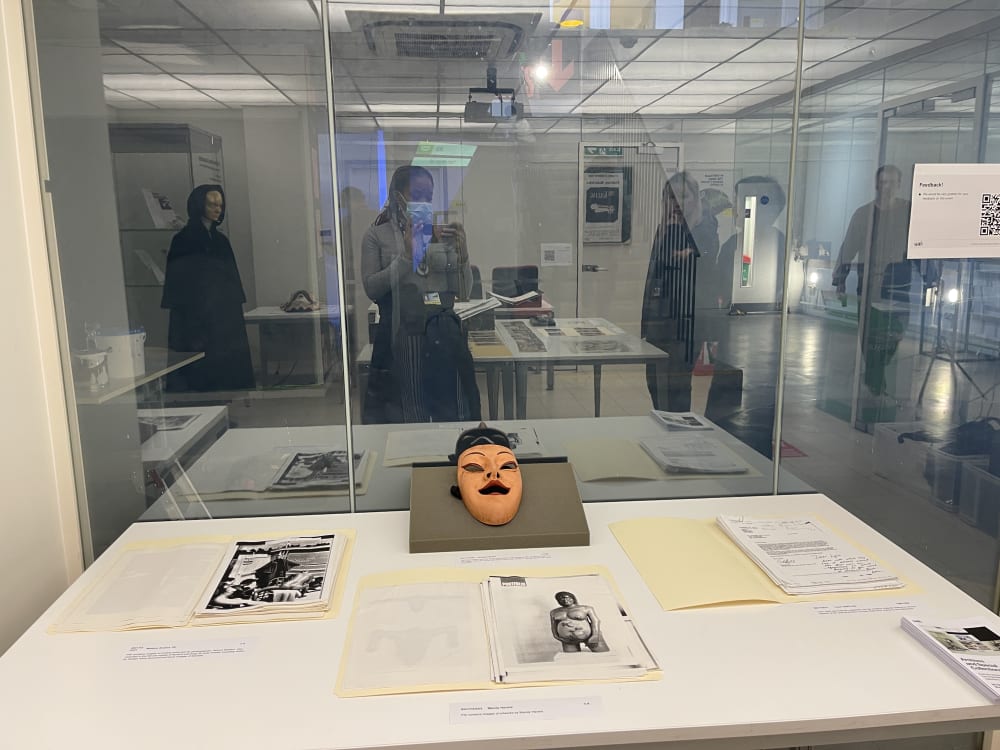
Stepping into Kubrick's World

- Written byWinifred Ahupa
- Published date 18 December 2024

Written by Winifred Ahupa, MA Global Collaborative Design Practice course at Camberwell College of Arts and Post-Grad Community Ambassador.
On a dreary London afternoon, the kind that makes one crave artistic escape, I found myself at the London College of Communication, drawn by the allure of Stanley Kubrick's genius. The event, a collaboration between the UAL Post-Grad Community and UAL Archives and Special Collections, focused on Kubrick's Eyes Wide Shut. Though the weather outside was grim, inside, I was transported to a world of cinematic brilliance and meticulous storytelling, soaking in the legacy of one of the greatest filmmakers of the 20th century.

As I entered, the table displays caught my attention—documents, props, and research materials that offered glimpses into Kubrick’s creative process. Nearby, the curator was engaged in a conversation with another attendee, their voices hushed in reverence for the artefacts before them. I waited patiently, my excitement growing as I prepared to delve into the mind behind films like The Shining, 2001: A Space Odyssey, and A Clockwork Orange.

Released in 1999, Eyes Wide Shut is a psychological drama adapted from Arthur Schnitzler’s novella Dream Story. Kubrick's film transplants the story from early 20th-century Vienna to 1990s New York City, exploring themes of desire, fidelity, and secrecy. It remains a deeply polarising piece of cinema, celebrated for its layered narrative and striking visuals.
Hearing the curator speak about the film’s production only deepened my appreciation. The meticulous research Kubrick undertook—from translating Schnitzler’s work to annotating it with his ideas—was astounding. I learnt how Kubrick, ever the perfectionist, had started envisioning the film as far back as 1972. His correspondence with the author’s son and collaborators, including Anthony Burgess, painted a picture of a man obsessed with getting every detail right.
The Kubrick Archive at LCC is a treasure trove, spanning over a kilometre in linear meters of material. It is the largest archive at UAL, offering unparalleled insight into Kubrick’s creative journey. The items on display were a small but fascinating selection:
- Masks from the masked ballroom scene, each one unique, evoking mystery and decadence.
- Costume research, including inspirations drawn from religious garments, was meticulously catalogued to maintain continuity during filming.
- Scripts annotated for costume consistency, such as notes ensuring Tom Cruise's character’s jacket was open during specific scenes.
- Concept art by Chris Baker (Fangorn), whose evocative illustrations for Eyes Wide Shut and Kubrick's abandoned Artificial Intelligence project highlighted his enduring collaboration with the director.

The curator's explanation brought these pieces to life. For instance, though the film is set in New York, Kubrick filmed it entirely in London, recreating Greenwich Village streets at Pinewood Studios. This blend of artistry and practicality underscored Kubrick’s resourcefulness.
As I sifted through the documents and absorbed the curator’s insights, I felt a profound connection to Kubrick's artistic ethos. His dedication to controlling every aspect of filmmaking—from research to distribution—resonated deeply with me as a designer, researcher and maker. I found myself marvelling at how he translated his vision into reality, bridged decades of preparation with precision and passion.

The highlight of my visit was seeing Kubrick's handwritten notes on Traumnovelle. His attention to plot holes and his quest to clarify them revealed a vulnerability rarely associated with such a towering figure. It was a reminder that even the greats grapple with doubts, using them as fuel to push boundaries.

Despite the rain and grey skies, my visit to the Kubrick archive was an unforgettable experience. It wasn’t just an exploration of a film—it was a window into a meticulous, creative mind that reshaped the art of cinema. The collaboration between the UAL Postgraduate Community and UAL Archives and Special Collections made this event even more meaningful, bridging the gap between academic exploration and creative inspiration.
As I left the exhibition, I felt inspired to bring the same level of thoughtfulness and dedication to my own work. For anyone who loves storytelling, design, or simply the magic of movies, Kubrick's archive is a must-see. It’s a journey through layers of creativity, a testament to what can be achieved when imagination meets rigorous craftsmanship.


Related links
- UAL Post-Grad Community
- Post-Grad Community Ambassadors
- Kubrick Archive in the UAL Archives and Special Collections Centre
Post-Grad Stories
A thriving online magazine of our postgraduate student voices sharing thought-provoking experiences, practices, thoughts and articles about what matters to them.
Download the PDF Guide to writing articles for Post-Grad Stories
Want to write an article? Get in touch with the Post-Grad Community team PGCommunity@arts.ac.uk
UAL Post-Grad Community
Established in 2013, Post-Grad Community is an inclusive platform for all UAL postgraduate students to share work, find opportunities and connect with other creatives within the UAL and beyond. Find out more.